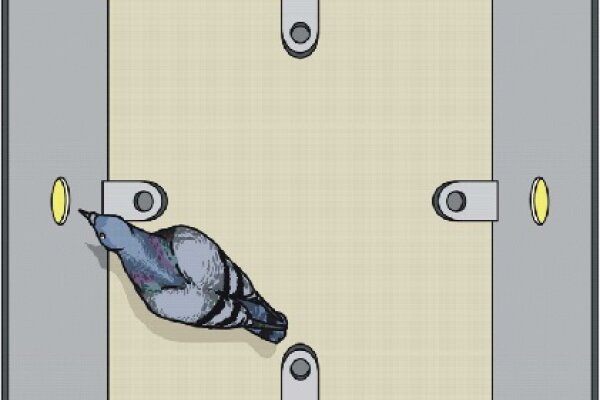2010-01-06

How does it feel to sense the magnetic field? How is it to actually "see" where North is? We humans do not know how it feels to sense the magnetic compass but we can study the mechanisms of this system in birds. Previous studies had shown that birds can "visualize" the magnetic compass directions and, in addition, can sense the strength of the local magnetic field. However, all attempts to actually train birds to learn a compass direction had failed. A new study by scientists from Frankfurt, Düsseldorf and the Biopsychology Department in Bochum now reports the first successful study on learning the magnetic compass direction. Pigeons were trained in an operant chamber with magnetic compass directions as true spatial cues. Experimental sessions were carried out in the local geomagnetic field and in magnetic fields with matched total intensity and inclination, but divergent directions generated with Helmholtz-coils. The animals successfully learned to peck those keys that were in the direction of the correct compass direction. Subsequently, the birds were tested in a true outdoor homing task. Astonishingly, the more successful individuals of the Skinner-Box learning experiment had worse initial orientations at unfamiliar, but not at familiar sites. The authors speculate that the better learners might have more self confidence to first explore unknown locations before taking the way back home. Future studies will show if this interpretation is correct.

How does it feel to sense the magnetic field? How is it to actually "see" where North is? We humans do not know how it feels to sense the magnetic compass but we can study the mechanisms of this system in birds. Previous studies had shown that birds can "visualize" the magnetic compass directions and, in addition, can sense the strength of the local magnetic field. However, all attempts to actually train birds to learn a compass direction had failed. A new study by scientists from Frankfurt, Düsseldorf and the Biopsychology Department in Bochum now reports the first successful study on learning the magnetic compass direction. Pigeons were trained in an operant chamber with magnetic compass directions as true spatial cues. Experimental sessions were carried out in the local geomagnetic field and in magnetic fields with matched total intensity and inclination, but divergent directions generated with Helmholtz-coils. The animals successfully learned to peck those keys that were in the direction of the correct compass direction. Subsequently, the birds were tested in a true outdoor homing task. Astonishingly, the more successful individuals of the Skinner-Box learning experiment had worse initial orientations at unfamiliar, but not at familiar sites. The authors speculate that the better learners might have more self confidence to first explore unknown locations before taking the way back home. Future studies will show if this interpretation is correct.